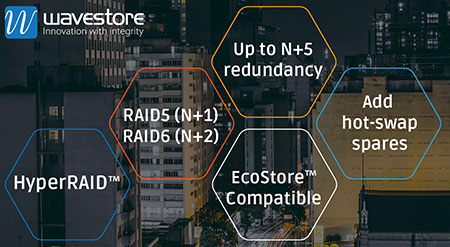
The resilience offered by the proprietary HyperRAID™ technology suite recently introduced by Wavestore, means that the risk of data loss due to hard drive failure can now be reduced to practically zero.
By taking the redundancy offered by conventional RAID solutions to a higher level, HyperRAID is able to provide peace of mind for applications where the safe storage of data and video evidence is crucial, from small projects up to fully integrated large scale and mission-critical solutions.
N+2 redundancy as standard
HyperRAID, which is capable of providing RAID5 (N+1) or RAID6 (N+2) redundancy, is designed to store data across multiple drives in an array. This means that if one or even two of the drives should fail, data will continue to be recorded and safely stored. Importantly, the data that is already stored on the array can still be read, thus ensuring that vital video evidence can be retrieved.
HyperRAID Plus offers up to N+5 redundancy
Regardless of the number of data storage drives in an array, HyperRAID Plus writes data across the drives in such a way that up to five of them can fail and yet recording will continue and all the recorded footage remains available for playback. This delivers a storage solution where the danger of data being lost because of drive failure is for all intents and purposes, non-existent, even if possible in theory. For example, in a system with 15 drives in an array set to N+5 redundancy, the risk of losing all data in a well-maintained system is estimated at just 0.000000000005%.
Saving on hardware components
?Not all RAID solutions are able to offer the same level of redundancy and in this respect, HyperRAID stands out from the crowd, even though it does not require any specialist knowledge to set up and manage ? said Julian Inman, Head of Product Management for Wavestore.
HyperRAID arrays do not need to be controlled by a RAID card. Instead they utilise a Host Bus Adaptor (HBA) within the recording server/NVR/HVR, which is a far more cost-effective component and enables HyperRAID to perform much faster than traditional RAID methods.
?This is because Wavestore?s unique Large Allocation Storage System (LASS) file system can control exactly where data is written to and doesn?t need to rely on RAID card technology to perform this function. In addition, another key benefit of LASS is that it arranges for data to be stored sequentially on each of the individual drives in the array, which reduces the wear and tear on the drives compared to conventional file systems when they are required to write and read data.?
Hot-swappable Drives
Users can be alerted by email if there is a problem with one of the drives, whilst to further enhance the level of redundancy, the HyperRAID technology suite also provides the ability to include hot-swappable drives in a recording server. These can be installed ready to automatically take over from any drive that has failed, in order to keep the full array intact. The new drive, which is brought into the array on the fly and without disruption to the ongoing storage of data, is automatically designated as a replacement for the failed drive in the array.
EcoStore™
HyperRAID is supported by Wavestore?s EcoStore? hard drive spin-down technology which delivers substantial real-world savings on the total cost of ownership of a video surveillance solution. EcoStore can automatically spin down hard drives and HyperRAID arrays which are not in a read or write state. Over 80% energy can be saved using EcoStore by spinning down drives. Associated cost savings are also achievable, such as reductions in air conditioning requirements and by limiting the wear and tear on disks that are always being powered on and spinning.
Source: wavestore.com

